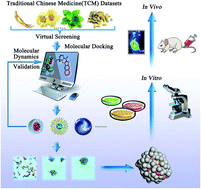Probing a dipeptide-based supramolecular assembly as an efficient camptothecin delivering carrier for cancer therapy: computational simulations and experimental validations†
Abstract
Short peptide-based supramolecular assemblies have drawn much attention in the field of drug delivery. However, the progress still remains limited owing to the inefficient drug loading capacity of conventional short peptide-based materials. In this study, based on coordinated intramolecular π–π stacking, we customize a dipeptide-based rhein derivative (rhein–diphenylalanine peptide, RDP), which could spontaneously form spherical nanoassemblies for drug delivery. A structure-based virtual screening of a library of small molecules is conducted to identify the suitable compounds which could be effectively delivered by this nanocarrier. Sorted by binding energy results, fifteen superior and five inferior molecules are found. Subsequently, the co-assembly capacity of high-affinity molecules (camptothecin, CPT) and low-affinity molecules (norcantharidin, NCTD) with the dipeptide-based carrier is predicted via dissipative particle dynamics (DPD) simulation. Consistent with computational results, the in vitro experimental results show that CPT-encapsulated nanoassemblies have significant advantages in the particle size distribution and recrystallization-inhibitory effect compared with NCTD. Furthermore, in vivo experiments were conducted to determine whether CPT is precisely delivered to tumor sites by using the dipeptide-based nanoassemblies. The CPT-loaded nanoassemblies show better effects in terms of drug biodistribution and in vivo anti-tumor efficacy compared to free CPT. The cooperative computational and experimental strategies (in vitro and in vivo) used in this work lay a good foundation to systematically understand short peptide-based assemblies for precise drug delivery.



 Please wait while we load your content...
Please wait while we load your content...